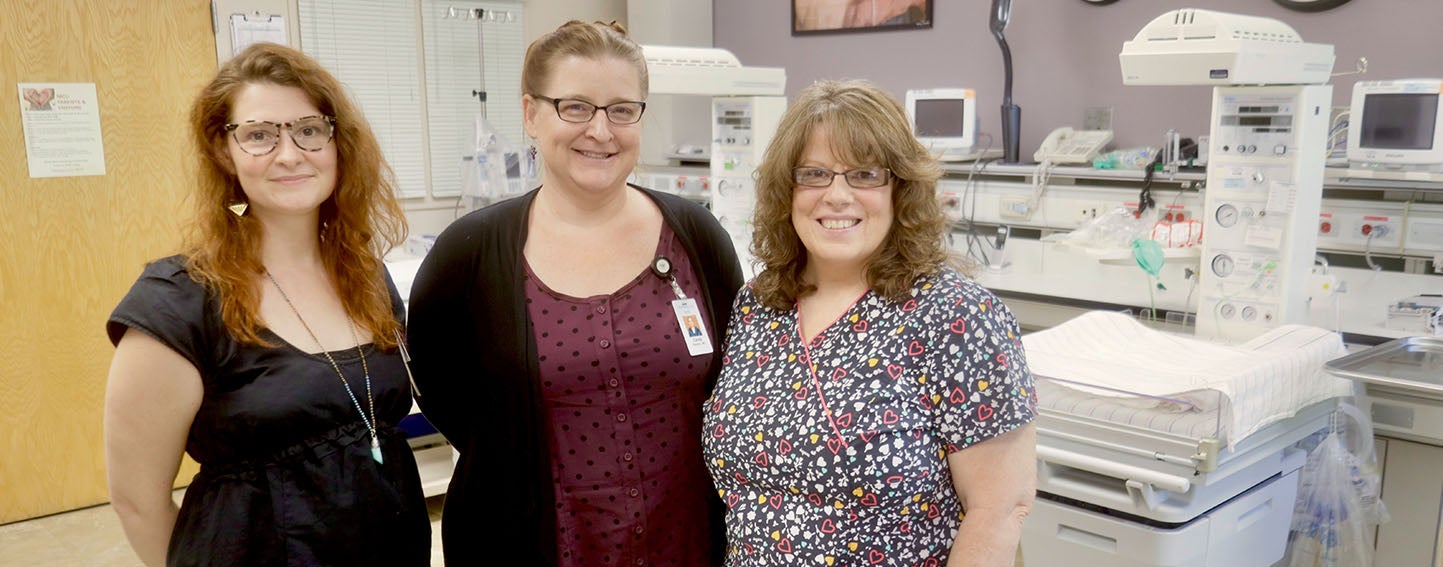News Paper Article the Power of Human Touch Helping Drug Babies Heal

When babies are born dependent on opioids, typically they are whisked away from their mothers, put into the neonatal intensive care unit of measurement (NICU), dosed with morphine to go them through withdrawal, and gradually weaned off the drug—a process that can accept weeks.
Research now suggests that this long-established standard of care may be the worst style to care for a newborn with opioid dependency, or neonatal abstinence syndrome (NAS). The NICU is busy, noisy, and bright, filled with beeping machines, other crying babies, and bustling nurses. Infants are fed non when they're hungry but every three hours on a schedule. When they cry, there may be no one to concord them if the nurses are busy attending to other babies. And when they finally tin can slumber, they may be awakened to exist poked and prodded for medical tests and treatments.
A new initiative is turning NAS handling on its head with a shockingly uncomplicated concept: treat the baby like a baby and the mom like a mom. Keep the infant and the mother together. Keep the baby out of the NICU. And don't give the infant opioids unless admittedly necessary.
This arroyo is known every bit "Eat, Slumber, Panel," meaning let the babies eat and sleep when they want and console them when they cry. With this protocol, hospitals treating members of Partnership HealthPlan of California — a Northern California Medi-Cal managed intendance organization — reduced the average hospitalization of babies with NAS from 18 days to xi days. Partnership said that in just the first three months of implementing the new approach, it saved $389,000. Studies at other institutions have shown newborns feel no adverse effects from this new protocol.
When the Standard of Care Is Wrong

To anyone who's taken care of an infant, Eat, Sleep, Console may sound obvious, but to physicians and nurses who treat babies with NAS, information technology'southward a revolutionary difference from decades of practice recommended by experts.
"Taking these babies from their moms and putting them in a nursery where it's noisy and lights are on has always seemed a little counterintuitive to what'southward best for them," said Susan Johnson, RNC, the NICU clinical coordinator at St. Joseph Infirmary in Eureka. "But it was what the standard was and what we were told to do."
Since the 1970s, the standard of care for NAS has been pharmacologic therapy — typically methadone or morphine — guided by the Finnegan Neonatal Abstinence Scoring System. The Finnegan system tests for symptoms of opioid withdrawal, such as shaking, fever, sweating, high-pitched crying, gastrointestinal problems, sneezing, and yawning. Babies are assessed every iii hours, and if they score eight or more on the Finnegan three times in a row, they are given medication. Once they're on the drug, it takes three to four weeks to wean them off, during which time they must remain in the hospital.
The problem is, many of the signs of opioid withdrawal expect similar typical newborn behaviors. "Information technology really pathologizes a lot of the symptoms that are normal in whatever given newborn," said Carrie Griffin, DO, a family medicine md in Humboldt County who specializes in perinatal substance use and treats moms and babies. "All babies yawn, all babies take some amount of a tremble response. And what happens is, when we know that in that location's been opioid exposure in utero, it'southward a different lens through which we're looking at these babies."
Learning That Mom Is Medicine
Consume, Sleep, Panel gets rid of the subjective Finnegan scoring system and but gives weight to a newborn's essential functions. Tin can the baby drink an ounce of milk? Sleep for an 60 minutes undisturbed? Be consoled within 10 minutes? If the infant is operation usually, then regardless of opioid exposure in the womb, the withdrawal isn't severe enough to warrant treatment with drugs.
The protocol was adult by Matthew Grossman, MD, an assistant professor of pediatrics at Yale School of Medicine. While caring for babies with NAS, he noticed that the infant's environment — and especially whether the infant was kept with its mother — had more touch on how chop-chop the baby was released from the hospital than the pharmacologic treatment did. So instead of automatically turning to opioids, Grossman decided that the showtime-line treatment would be the mom.
It turns out that when the babies are given mom instead of morphine, they practice better. With Eat, Slumber, Panel, the boilerplate length of stay for infants born with NAS at Yale New Oasis Children'due south Hospital dropped from 22 days to 4 days. What's more, simply 12% of newborns treated with Eat, Slumber, Panel required opioids compared with 62% of babies scored using the Finnegan model. These changes cut the toll of intendance per infant by more than seventy%.
Watch this presentation about Consume, Sleep, Console by Yale pediatrician Matt Grossman, MD.
A Female parent's Affect
Nicole Merschdorf was 1 of the start women to go through the new protocol with her daughter Penny Lou at Mad River Community Hospital in Arcata, California. Merschdorf had been using intravenous drugs for five years, and she was on buprenorphine to care for her habit when the baby was delivered. Buprenorphine is a kickoff-line treatment for opioid addiction, and while information technology can lead to NAS in babies born to pregnant women taking the medication, the NAS is usually less astringent. Buprenorphine helps the women maintain a more stable life without experiencing withdrawal and cravings while in handling.
When Penny Lou was built-in, she showed signs of NAS, like restlessness, jerkiness, sneezing, and overactive sucking. But Merschdorf said that as soon every bit she did skin-to-skin contact with her babe, "It was really all the difference in the globe," she said. "She'd be fussing in her bassinet, and as soon every bit yous picked her up and she felt a body, she'd instantly exist soothed."
Merschdorf and her daughter were able to stay in a private room in the nursery for seven days before Penny Lou was deemed healthy plenty to get abode. The baby girl required only a single dose of morphine on the second 24-hour interval. The i-off treatment — another departure from the Finnegan model — was enough to get her through the worst of her withdrawal without requiring a total course of the drug. Now Penny Lou is a happy, healthy six-month-sometime infant.
"When the baby is born, in that location's a massive corporeality of guilt and regret," Merschdorf said. "But the doctors and nurses are in that location to help you lot. And getting the best medical treatment for your child is what's going to exist best for them in the long run."
Changing Clinicians' Minds
In rural Humboldt Canton forth California's northern declension, more 10% of newborns are diagnosed with NAS, the second highest rate in the state. Griffin, the family medicine medico, has spearheaded the rollout of Eat, Slumber, Console in several Humboldt hospitals, including St. Joseph Infirmary and Mad River Community Hospital. Since the program started, most of the babies have gone habitation afterwards four days, and Penny Lou was the only one who required pharmacologic treatment.
Most babies and children would rather exist cuddled by their parents when they're feeling ill than have somebody sedate them and make them sleep through the symptoms.
—Candy Stockton, Medico
Griffin said that while she is excited past their initial success, she'south even so working to get buy-in from all the care providers. "There'southward been a lot of resistance from pediatricians hither considering they feel like the babies are suffering, and nosotros're non doing anything to mitigate it," she said. "It is difficult to unwind those years of training and assessing and clinical design development and reorient around the idea that this is a healthy baby. The babe is experiencing withdrawal from the substance, but if we support them as we would want to support any newborn, they do really well."
To help go more of the doctors and nurses on lath, Griffin and Candy Stockton, MD, a family unit physician at the Humboldt Independent Exercise Clan and head of the canton'southward perinatal substance apply chore strength, have been trying to reframe what the true source of suffering is for these children.
"Near babies and children would rather be cuddled by their parents when they're feeling sick than have somebody sedate them and make them sleep through the symptoms," Stockton said. "Putting the baby in a brightly lit, noisy, chaotic environs in the neonatal intensive intendance unit of measurement, separating them from their parents and caregivers to provide this intendance — all of those things are more traumatic to an baby who doesn't sympathise what's happening than it is for them to be a footling shaky with a little bit of nausea and some muscle aches."
Teaching Is Key
This type of clinician pedagogy is disquisitional equally Partnership HealthPlan of California works to get more hospitals to roll out Consume, Sleep, Console. The initiative began with a one-twenty-four hour period conference on maternal opioid employ in October 2018, at which Grossman presented the protocol. His talk had a dramatic and firsthand effect on many of the intendance providers at the 22 hospitals in Partnership'due south network. While the average reduction in length of stay was from 18 to 11 days, the hospitals that were most committed to Consume, Sleep, Console got their average stay down to just iv days. As more hospitals prefer the program, the average length of stay is likely to continue dropping.
"Education is usually not your strongest mode of making change happen on a massive scale," said Robert Moore, Dr., Partnership's master medical officer. "But the bear witness is and then overwhelming that when doctors heard a single presentation [on Consume, Sleep, Panel], we saw this big modify."
Partnership is collaborating with the California Maternal Quality Care Collaborative to go on education around the new protocol, concentrating on 4 rural Northern California jurisdictions that accept been particularly difficult-hit by the opioid crisis: Humboldt, Lake, Mendocino, and Shasta Counties. As more providers acquire about the handling, Moore hopes hospitalization times and health care costs volition continue to drop equally this improved approach to neonatal abstinence syndrome takes hold.
"Keeping the knowledge out there is going to be really of import," Moore said. "Ultimately, learning more on the footing — how are they thinking about these barriers, what are their plans to accost the barriers — and keeping that dialog live is going to be helpful."
Source: https://www.chcf.org/blog/opioid-dependent-newborns-get-new-treatment/

Post a Comment for "News Paper Article the Power of Human Touch Helping Drug Babies Heal"